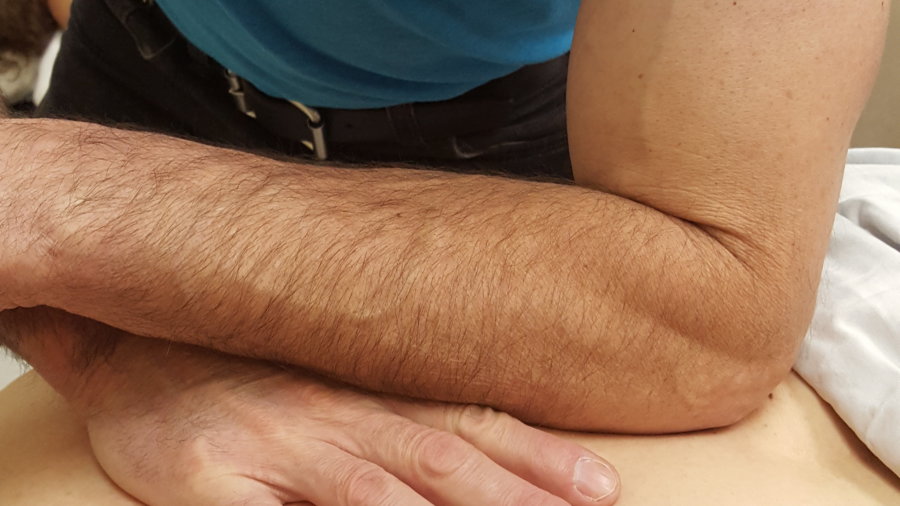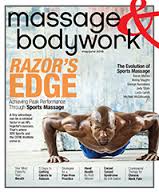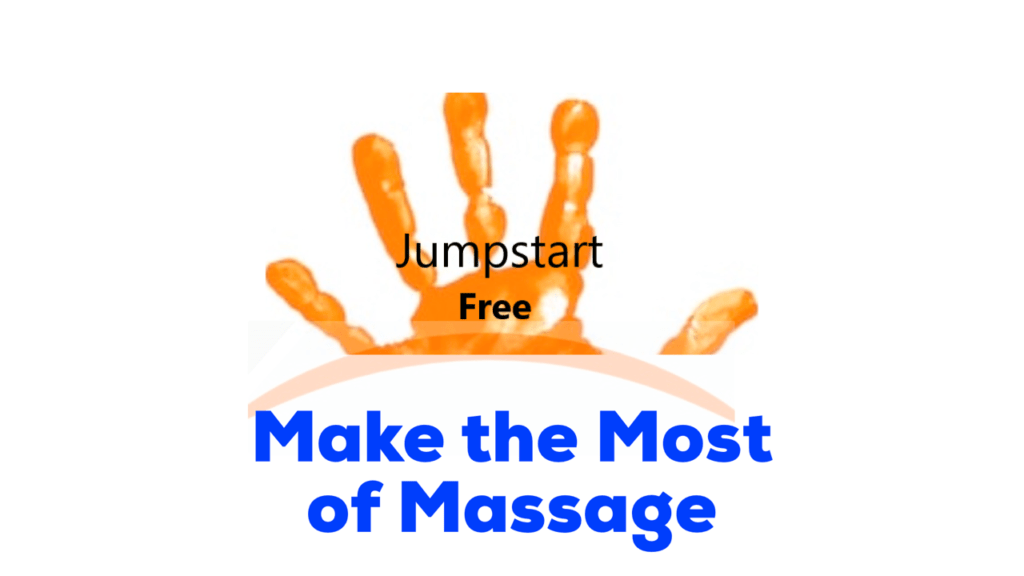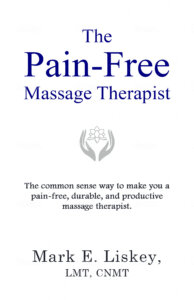Will working on a low massage table hurt your back?
Not if you adopt these strategies:
(1) use the table for support,
(2) take wider stances when doing lighter pressure,
(3) incorporate seated work and
(4) avoid static posture positions.
When you do those four things you’ll be able to deliver all ranges of pressure efficiently and with minimal strain on your body.
I know, I sound pretty confident with that answer.
Here’s why: For about 20 or so years my massage table height was normal.
Hold on there, Mark, what’s normal?
Good question.
Normal to me was setting my table height so that the first knuckle of my middle finger would touch the top of the table.
Edward Mohr recommends figuring out your table height by first trying your table at half your height.
Bottom line, there is no consensus on what normal should be, but we can say this about normal: It has recognizable boundaries.
In other words, we all recognize when a massage table height is out of the normal range.
All least my clients do: “Hey, Mark, is your table too low? Isn’t that gonna hurt your back?”
So, for about 20 years I set my massage table height within the normal range and clients weren’t worried about my back.
Then about 5 years ago all hell break loose. I was diagnosed with cervical radiculopathy, cubital tunnel syndrome and shoulder instability.
The way I was doing massage was killing my body, and I needed to find another way to get the job done.
Here’s the short version of what happened next. Because my neck and shoulder hurt when I did deep work with my forearm, I needed to find an alternative to my forearm.
Enter fists.
Massaging with Fists
But there was a problem with fists at the normal table height. I couldn’t transfer my body weight onto the client. So, I’d have to use a whole lot of pressing action with my upper-body to generate deeper pressure which meant more stress in my neck and shoulder.
So, I lowered the table so that I could lean (transfer) my body weight through my fists onto the client.
Bingo!
Deep pressure was easy do when I did that.
But no one is just going to use fists throughout an entire massage, right? And when fingers and palms and forearms start to come out, the table is going to be too low. One case of back strain coming up!
That’s 100% true UNTIL you learn how to adapt to a low massage table.
My adaptation process was accelerated last year when I decided to do a Can My Massage Table Be Too Low? experiment. For 7 days, I set my table on the lowest setting possible for each client I saw, no matter if they were big or small, thick or thin.
Guess what happened to my body?
Nothing.
Now I’ve taken it even a step further and two months ago I set my massage table at the lowest setting possible for each and every massage.
I don’t plan on ever changing that.
Why Stay Low?
I’m sticking with low for two reasons. One, I can generate pressure effortlessly by simply transferring my body weight onto the client.
And, two, I know how to adapt to a low table so that my back is fine.
Here’s a quick primer on how to lean when using a low massage table.
[embedyt] https://www.youtube.com/watch?v=NhBh2cdGz6A[/embedyt]
And here’s how you adapt to a low massage table.
Low Massage Table Hurt Your Back NOT – Adaptations
A low table looks scary, like it’s going to hurt your back–but it won’t.
The Can My Massage Table Be Too Low? experiment put a spotlight on 4 things that had to be done in order to successfully adapt (no strain in your back) to a lower table.
Let’s tackle these four things right now.
1. Bend your legs.
Here I’m delivering deep pressure with my knuckles and fists. The table is low so that I can lean into client.
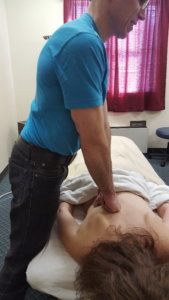
But when I want to lighten the pressure it gets more complicated. I can either bend at the back and cripple myself OR bend my legs like I’m the Karate Kid.
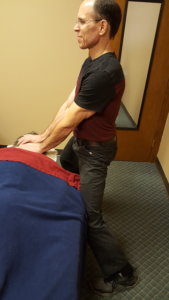
It will feel a little weird at first when you start doing Karate Kid stances, but you’ll love the results. No back pain.
During the experiment I took bending my legs to whole new level. But I didn’t fatigue because of thing number #2.
2. Use the table for support.
Think of the table as a wall to lean against. Use it to support your weight.
Look at my back leg in this pic. A lot of my weight is being directed into the table through my leg.
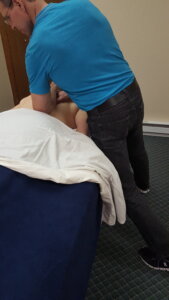
Here I’m leaning into the table in a Karate Kid stance. (Notice how I can really get into the lamina groove on this person….haha…)
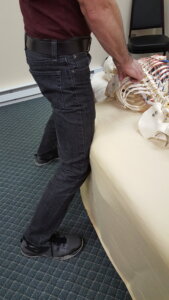
Once you get that “the table can help hold you up”, you start looking for ways to rest against the table. And you begin to…
3. Approach massage as dynamic work, not static work.
By dynamic I mean moving and flowing with a purpose in mind–to effortlessly do a good massage.
Here’s a movement sequence that happens naturally when you bend your legs and use the table as support.
Deep pressure first.
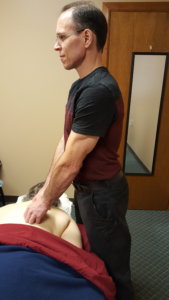
Relax your back.
Then I bend my legs for light pressure on the neck.

In this light pressure situation I switch to one hand and get vertical. Notice my leg against the table. I’m still using the table as support.
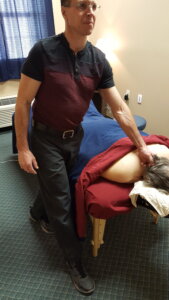
And at the end I throw in a stretch.
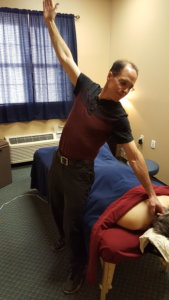
It may look like a lot of work, but if you’re at one with your massage table (using the table to support some of your weight), massage becomes effortless.
4. Sit when you can.
I have to come clean. The reason I perfected seated massage was because my toe hurt at the end of long work days and I was tired of adjusting the massage table for each client.
So, one day I kept my table height on the lowest setting for everyone. And when a light pressure client came in guess what I did?
You got it. I sat down for a lot of the massage.
It worked great. (And later with other clients I discovered how to generate deeper pressure when sitting, especially in areas like the traps.)
Want to know more about sitting on your butt to do massage? Check out How to Use a Massage Stool.
A Low Massage Table Won’t Hurt Your Back in a Nutshell
After you use the strategies that I’ve talked about for working on a low table the question actually changes to: Can your massage table be too high?
And my answer is yes.
If your massage table is too high for you to lean to generate pressure then you’re going to have to press really hard with your upper-body.
You may be able to get the job done, but at what cost?
Your hands, arms, shoulders and neck will let you know.
Whereas, if you have a low massage table, medium and deep pressure is a slam dunk.
And during times when a low table is not optimal for your back (like thin people and light pressure), you can easily adapt to a low table by bending your legs, using the massage table for support, breaking up static posture positions and sitting to do massage when you can.
This video brings it all together:
 Read my articles and watched my videos, but deep pressure still kicks your butt?
Read my articles and watched my videos, but deep pressure still kicks your butt?
I can help.
From 1,000 miles away?
Actually, yes. Click here.
